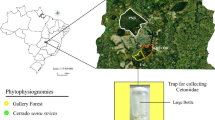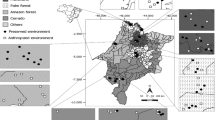Abstract
This study highlights the species diversity of Ceratopogonidae from the Paranaense forest and adjacent grassland in a protected natural area of Argentina, and emphasizes the importance of conserving the last remaining marginal forest area surrounded by a strong urbanization. A total 46 species belonging to 10 genera were recorded from these two habitats. Species diversity was higher in the grassland, while dominance was greater in the forest. Twelve species were abundant, while the rest were scarce or rare. The composition of the ceratopogonid community differs between habitats: 15 species were exclusive to the forest, 4 to the grasslands, and 27 used both habitats indistinctly. Differences between habitats were observed in the abundances of Alluaudomyia schnacki Spinelli, Atrichopogon albinensis Ingram and Macfie, and Forcipomyia rioplatensis Marino and Spinelli. The sex ratio of the most abundant species did not show a definite pattern in relation to the habitats, except for Culicoides caridei (Brèthes), in which females were dominant. Atrichopogon balseiroi Spinelli and Forcipomyia williamsi Marino & Spinelli have only been recorded in Buenos Aires Province and were found exclusively in the forest during this study.

Similar content being viewed by others
References
Borkent A (2004) The Biting Midges, the Ceratopogonidae (Diptera). In: Marquardt WC (ed) Biology of disease vectors, 2nd edn. Elsevier Academic Press, Burlington, Massachusetts
Borkent A (2016) World species of biting midges. Diptera, Ceratopogonidae
Borkent A, Spinelli GR (2007) Neotropical Ceratopogonidae (Diptera: Insecta). Aquatic Biodiversity in Latin America (ABLA). Pensoft, Sofia-Moscow 198 p
Bravo JC, Somarriba E, Arteaga G (2011) Factores que afectan la abundancia de insectos polinizadores del cacao en sistemas agroforestales. Revista de Ciencias Agrícolas 28(1):119–131
Cabrera AL, Dawson YG (1944) La selva marginal de Punta Lara en la ribera argentina del río de La Plata. Rev Mus La Plata, Bol 5:267–382
Cabrini I, Grella MD, Andrade CFS, Thyssen PJ (2013) Richness and composition of Calliphoridae in an Atlantic Forest fragment: implication for the use of dipteran species as bioindicators. Biodivers Conserv 22:2635–2643
Cazorla CG (2016) New records of “jejenes” on the subgenus Stilobezzia of Stilobezzia (Diptera: Ceratopogonidae) from the Neotropical region. Revista de la Sociedad Entomológica Argentina 75:186–190
Cazorla CG, Campos RE (2019) Synanthropy and community structure of Ceratopogonidae from the northeast of Buenos Aires province, Argentina. J Med Entomol 56(1):129–136
Cazorla CG, Díaz F. In press. Schizonyxhelea thomsenae (Wirth), description of the pupa and first records from Argentina, Brazil and Peru (Diptera: Ceratopogonidae). An Acad Bras Cienc
Cazorla CG, Marino PI, Díaz F, Campos RE (2018) Diversity of Ceratopogonidae (Diptera: Culicomorpha) from the Reserva Natural Integral Punta Lara (Buenos Aires, Argentina). Revista de la Sociedad Entomológica Argentina 77(3):1–13
Corbi JJ, Froehlich CG, Trivinho-Strixino S, dos Santos A (2011) Evaluating the use of predatory insects as bioindicators of metals contamination due to sugarcane cultivation in neotropical streams. Environ Monit Assess 177:545–554
Debenham ML (1987) The biting midge genus Forcipomyia (Diptera: Ceratopogonidae) in the Australasian region (exclusive of New Zealand). III. The subgenera Forcipomyia, s.s., and Lepidohelea. Invertebr Taxon 1:631–684
de Meillon B, Wirth WW (1991) The genera and subgenera (excluding Culicoides) of the Afrotropical Biting Midges (Diptera: Ceratopogonidae). Ann Natal Mus 32:27–147
Di Rienzo JA, Casanoves F, Balzarini MG, González L, Tablada M, Robledo CW (2017) InfoStat version 2017. FCA, Universidad Nacional de Córdoba, Argentina, Grupo InfoStat. http://www.infostat.com.ar
diCastri F, Vernhes JR, Younès T (1992) Inventory and monitoring biodiversity. Biol Int (Special Issue) 27:1–27
Dinerstein E, Olson DM, Graham DJ, Webster AL, Primm SA, Bookbinder MP, Ledec G (1995) Una evaluación del estado de conservación de las ecoregiones terrestres de América Latina y el Caribe. WWF and World Bank, Washington D.C, 176 p
Free G, Solimini AG, Rossaro B, Marziali L, Giacchini R, Paracchini B, Ghiani M, Vaccaro S, Gawlik BM, Fresner R, Santner G, Schönhuber M, Cardoso AC (2009) Modelling lake macroinvertebrate species in the shallow sublittoral: relative roles of habitat, lake morphology, aquatic chemistry and sediment composition. Hidrobiología 633:123–136
Guerrero EL, Deschamps JR, Tonni EP (2018) La Selva Marginal de Punta Lara, ¿relicto o colonización reciente? Revista del Museo de La Plata 3(2):348–367
Herrera R, Torres Robles S (2012). Comunidades vegetales de la Reserva Natural Punta Lara. In: Roesler I, Agostini, MG (eds) Inventario de los vertebrados de la Reserva Natural de Punta Lara, provincia de Buenos Aires, Argentina. Temas de Naturaleza y Conservación, Monografía de Aves Argentinas N° 8. Buenos Aires, Argentina
Hurtado MA, Giménez JE, Cabral, MG, Silva, M, Martinez OR., Camilión M. C., Sánchez CA, Muntz, D, Gebhard JA., Forte LM., Boff L, Crincoli A, Lucesoli H (2006) Análisis ambiental del partido de La Plata: Aportes al ordenamiento territorial. Consejo Federal de Inversiones, Facultad de Ciencias Naturales y Museo. La Plata, Argentina
Kim KC (1993) Biodiversity, conservation and inventory: why insects matter. Biodivers Conserv 2:191–214
Londoño JC (2003) Estructura de la comunidad de macroinvertebrados acuáticos asociados a macrofitas flotantes y su relación con la calidad del agua en la ciénaga Colombia. Caucasia, Antioquia. Revista Ingeniería 3:105–120
Magurran A (1988) BIO-DAP – ecological diversity and its measurement. Fundy National Park, Alma, New Brunswick
Marino PI, Cazorla CG, Díaz MF (2011) Los Ceratopogonidae (Diptera: Nematocera) del Sistema Serrano de Ventania, Buenos Aires, Argentina. Revista de la Sociedad Entomológica Argentina 70(3–4):197–205
Medianero E, Samaniego M (2004) Comunidad de insectos acuáticos asociados a condiciones de contaminación en el río Curundú, Panamá. Folia Entomol Mex 43(3):279–294
Moreira RG, Fernandes GW, Almada ED, Santos JC (2007) Galling insects as bioindicators of land restoration in an area of Brazilian Atlantic Forest. Lundiana 8(2):107–112
Morello J, Buzai GD, Baxendale CA, Rodríguez AF, Matteucci SD, Godagnone RE, Casas RR (2000) Urbanization and the consumption of fertile land and other ecological changes: the case of Buenos Aires. Environ Urban 12(2):119–131
Muñoz-Riveaux S, Naranjo-López C, Garcés-González G, González Lazo DD, Musle-Cordero Y, Rodríguez-Montoya L (2003) Evaluación de la calidad del agua utilizando los macroinvertebrados bentónicos como bioindicadores. Revista Chapingo. Serie Ciencias Forestales y del Ambiente 9(2):147–153
Natoli G, Roesler I, Novoa D (2012) La Reserva Natural Punta Lara: ubicación, clima y marco normativo. In: Roesler I, Agostini MG (eds) Inventario de los Vertebrados de la Reserva Natural Punta Lara, provincia de Buenos Aires, Argentina. Temas de Naturaleza y Conservación, Monografía de Aves Argentinas No 8. Buenos Aires, Argentina
Novoa D (2012) Historia de la Reserva Natural Punta Lara. In: Roesler I, Agostini MG (eds) Inventario de los Vertebrados de la Reserva Natural Punta Lara, provincia de Buenos Aires, Argentina. Temas de Naturaleza y Conservación, Monografía de Aves Argentinas No 8. Buenos Aires, Argentina
Pielou EC (1984) The interpretation of ecological data. John Wiley & Sons, New York 263 p
Ribera I, Foster G (1997) El uso de artrópodos como indicadores biológicos. Sociedad Entomológica Aragonesa 20:265–276
Ronderos MM, Spinelli GR, Lager I, Díaz F (2003) La importancia sanitaria de los jejenes del género Culicoides (Diptera: Nematocera) en la Argentina. Entomología y Vectores 10:601–612
Scheirer C, Ray W, Hare N (1976) The analysis of ranked data derived from completely randomized factorial designs. Biometrics 32:429–434
Sokal RR, Rohlf FJ (1995) Biometry. WH Freeman and Co, New York 887 p
Spinelli GR, Balseiro EG (1982) Observaciones relativas a la actividad nocturna de ceratopogonidae (Diptera, Nematocera) en la zona de los Talas (Provincia de Buenos Aires) mediante el empleo de una trampa de luz. Revista de la Sociedad Entomológica Argentina 41:225–232
Spinelli GR, Ronderos MM, Balseiro EG (1989) Análisis de la actividad diaria de dípteros nematoceros en Punta Lara (Pdo. Ensenada, Prov. de Buenos Aires) II. Ceratopogonidae con la descripción de una especie nueva en el género Atrichopogon. Limnobios 2:733–737
Vane-Wright RI, Humphries CJ, Williams PH (1991) What to protect? – systematics and the agony of choice. Biol Conserv 55:235–254
Wirth WW, Marston N (1968) A method for mounting small insects on microscope slides in Canada Balsam. Ann Entomol Soc Am 61:783–784
Zar JH (1996) Biostatistical analysis, 3rd edn. Prentice Hall, New Jersey, USA 662p
Acknowledgments
We thank Florentina Díaz (Centro de Estudios Parasitológicos y de Vectores) and Pablo Marino (División Entomología, Museo de La Plata) for their help in the taxonomic identification of Dasyhelea and Forcipomyia species, respectively. We also thank the authorities of the Reserva Natural Integral Punta Lara for the logistics to conduct this study. The project was evaluated by the committee for the Management of Protected Areas and Conservation of Diversity belonging to the Organismo Provincial de Desarrollo Sustentable (OPDS). This agency approved the methodology and granted the corresponding permission to conduct the studies. The authors are members of the Consejo Nacional de Investigaciones Científicas y Técnicas (CONICET).
Funding
This study was supported by grant PIP 0399 from Consejo Nacional de Investigaciones Científicas y Técnicas.
Author information
Authors and Affiliations
Contributions
Carla G. Cazorla and Raúl E. Campos planned this work and contributed to the data collection, data analysis, and interpretation, and they wrote the manuscript.
Corresponding author
Additional information
Publisher’s Note
Springer Nature remains neutral with regard to jurisdictional claims in published maps and institutional affiliations.
Edited by Patrícia J Thyssen – UNICAMP
Rights and permissions
About this article
Cite this article
Cazorla, C.G., Campos, R.E. Ceratopogonidae (Diptera) Communities in a Protected Area Threatened by Urbanization. Neotrop Entomol 49, 361–368 (2020). https://doi.org/10.1007/s13744-020-00768-9
Received:
Accepted:
Published:
Issue Date:
DOI: https://doi.org/10.1007/s13744-020-00768-9




